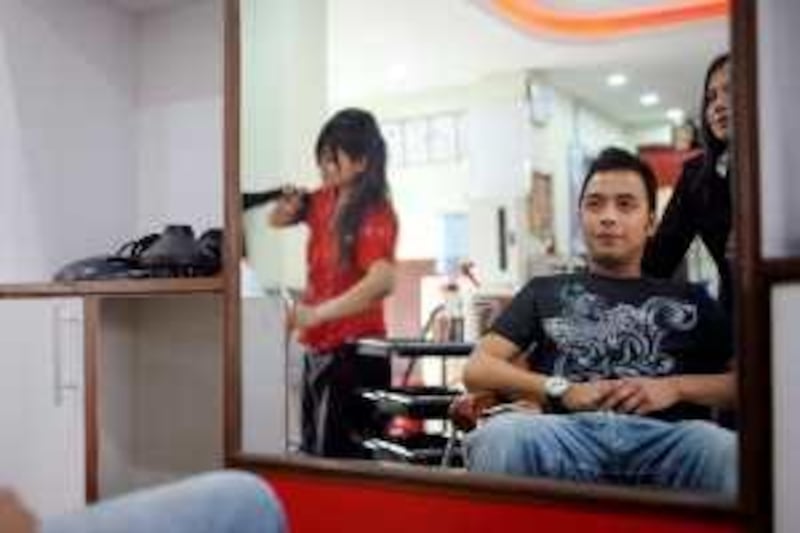KATHMANDU // Ever since Beauty Clubs opened its doors to Nepal's image-conscious, the salon director, Sandra Pun, and her team have not been able to put their scissors down. Over the last three years, the business has seen a steady flow of Nepali celebrities, teenagers and housewives in demand of the house special: the South Korean look. The salon could not have opened at a more opportune time.
The Korean Wave or Hallyu, as dubbed by Chinese journalists, refers to the gathering momentum of South Korean popular culture. Since the mid-1990s, the country's music, film and food has found a huge following in East Asia and other corners of the world. Over the last five years, a surge of South Korean soap operas and films propagated by video piracy has permeated Nepali soft culture. And the cool kids in Nepal's urban triangle, Pokhara, Kathmandu and Dharan, are following suit. You can see them at cafes and rock bars, imitating the sleek style and lightened, textured hair of South Korean actors.
Ms Pun, the salon director, estimates that 80 per cent of her daily clients ask for a Korean hairstyle, the majority being teenagers through to men and women in their mid-20s. Having spent 12 years training in Seoul, she believes such hairstyles are increasingly desirable because of the two countries' cultural similarities and the likeness of Korean and Nepali physical features. "Nepal is upgrading now and every time I see teenagers, guys and girls, they are dressed like Koreans. They are slowly catching up."
Industrial packs of straightening cream and hair dyes line the salon walls and, at the counter, a mini Hindu shrine sits alongside a signed poster of the South Korean actor Jang Dong Gun. Whitening lotions and imported cosmetics all promise the Korean look. But it is not just the stylish youth that come here. A number of Nepal's most fashionable media personalities and celebrities regularly visit the salon.
Nima Rumba, 36, is no exception. As Nepal's Coca-Cola poster boy and one of the country's most celebrated pop stars, Rumba sees Ms Pun for a new Korean hairstyle at least every two months. Today, as he enters the salon, a wide-eyed youth loses her composure and starts shaking to see him in person. While Rumba is a fixture on the Nepali popular culture scene, he accedes that the South Korean alternative has made huge waves.
"People are just crazy about these Korean serials and the food. Korean pop culture has made a big, big impact." Kashish Shrestha, former editor of Wave, Nepal's English language youth magazine, said South Korean films attract middle to upper class enthusiasts. "Their films are so stylish, so sleek, so polished and I think this really appeals to this new breed of youth that grew up watching satellite TV and have access to the internet."
Gopal Shrestha, 62, runs a busy, dimly lit pirated DVD stall in Kathmandu. Because of the little demand, Mr Shrestha has culled Nepali films from his stock, concentrating on foreign-language orders. In the six years he has had the shop, he said he has seen Korean films rise in popularity and has added crates of Korean romantic comedy, horror and action movies. Of the hundreds he sells a day, at least 50 are Korean films.
For Nepali filmmakers and musicians, Korean pop culture also has been influential. Alok Nembang's first film, Sano Sansaar, was pitched at Nepal's middle-class youth. Nembang said he deliberately tried to convey the "fresh, feel-good look" of Korean romantic comedies and the film's introduction is modelled on a Korean production, Sassy Girl. South Korean films, which often combine Confucian ideals, love and family values but are devoid of politics and nudity, are both something that Nepali filmmakers can aspire to and emulate, believes Nembang.
"I think we can adapt Korean films because there are no racy sex scenes, no nudity. This is something we are used to. It is still considered taboo to show sex scenes." The simplicity of the themes and cultural similarities are another reason why Nepali youths may enjoy Korean films. "Being an Asian country our culture is quite similar. The way they take food, the way they decorate their homes ? we feel closer to them," said Rinasha Rai, 22, a choreographer.
Yet for the Himalayan nation, currently grappling with the aftermath of a decade-long civil war and a divided coalition government struggling to give shape to the federal republic, South Korea may have more to offer than just pop culture. At present, with 16 hours of rolling blackouts and more people seeking employment offshore, South Korea is an example of development and modernity for Nepali youth.
Gagan Thapa, a member of the Nepali Congress and a youth leader traces this back to 1953 when an armistice ended the Korean War and left South Korea and Nepal's per capita income on par. At the time Nepal donated sacks of rice to South Korea, and this is what put the country on the map for Nepalis. "A large number of people have this understanding of Korea as developing quickly in a very short span of time.
If you listen to any political speeches in Nepal, any leader who is talking about really fast-paced change gives the example of South Korea. If they can do it, why can't Nepal?" * The National






